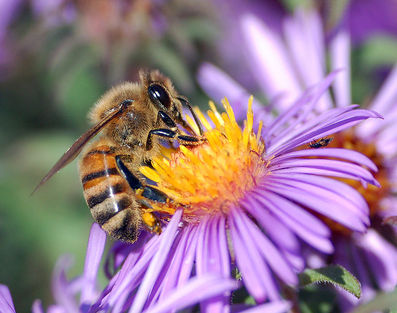Many people ask the question: "Where does honey come from on the bee?"
However, to be perfectly honest, honey doesn't come directly from bees. Bees make honey from nectar. Nectar is the main honey-making element.
However, to be perfectly honest, honey doesn't come directly from bees. Bees make honey from nectar. Nectar is the main honey-making element.
Worker bees go from flower to flower drinking the nectar. It doesn't go in to the bee's stomach but into a special storage sac called the honey crop. As she swallows the nectar she adds enzymes to it from special glands which start the process of breaking down the complex sugars like sucrose into simple sugars like glucose and fructose. The bee will add enzymes to the swallowed nectar to purify the substance from bacteria.
When the forager bee returns to the hive she passes the nectar to one of the hive bees who adds more enzymes, this time to prevent fermenting. The nectar may be passed from bee to bee in this way several times before it is finally deposited into a cell on the honeycomb. The enzymes added by the bees are important in converting the nectar into honey. They also produce compounds which give honey its anti-bacterial and anti-fungal properties.
When the nectar is first stored it contains up to 90 percent water. With this amount of water it wouldn't store for long without fermenting, so the bees fan the cells with their wings. This air movement, together with the heat in the hive, evaporates the water. When the water content is down to about 16 percent the bees consider the honey ready and seal the cells with caps of beeswax until the honey is ready to be eaten.
Bees always produce more honey than they need in case they need extra food when flowers are not blooming or in season.
It is this way that raw honey is made.


 RSS Feed
RSS Feed